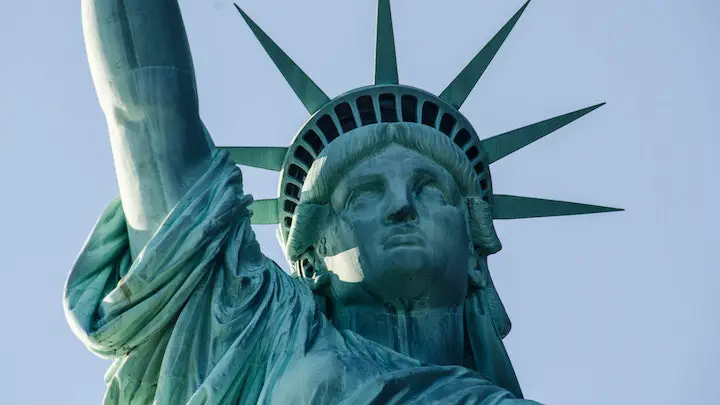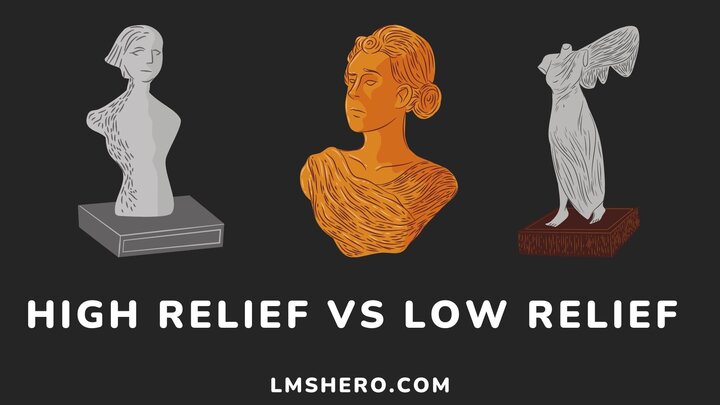High and low-relief sculptures are prominent carvings carried out on a wall or any solid background. This concept remains one of the oldest practices in sculpting and is adorned by millions of people worldwide.
To easily differentiate both can be difficult If you are not an archaeologist or a scientist. This article contains the major difference between these sculptures and other things you need to know.
What is Relief Sculpture?

A relief sculpture is any artwork that emanates from a wall or a solid surface. In other words, the sculpture is carved or chiseled from a wall.
Relief sculptures require less work and still manage to provide a 3-dimensional perspective. This makes them very superior to paintings, drawings, or welded products.
What is Low Relief Sculpture?
Low-relief sculpture or a bas-relief is a form of artwork that protrudes slightly above the rock or surface material. This is because just a minimal amount of the background has to be removed.
The earliest form of these sculptures were carvings in caves where early men sought shelter against adverse weather conditions. Most of these sculptures did not survive antiquity.
Features of bias relief
- Most sculptures are etched on metal or stone. Mixing different surface materials is also not a common practice in this technique.
- They feature a scene with many figures on a single rock or metal because they are more structurally sound than high-relief sculptures.
- The varieties of materials that create relief sculptures over the years include gold, silver, bronze, terra-cotta, marble, and ivory.
- Donatello was a primary figure during the Italian Renaissance. He carved low relief sculptures on bronze representing figures from the Christain faith.
Examples of Relief Sculpture
1. The Greek Parthenon is a significant building in Greece with various interior and exterior bias reliefs. The temple was built in honor of the Greek goddess Athena in the 5th century B.C.
2. Italian cathedrals and major religious or political buildings also feature this form of sculpture. This includes the Parisian Arc de Triomphe.
3. Prominent palaces in the Middle East and Asia also have small and large-scale low-relief sculptures. This includes sculptures of elephants, horses, bulls, and lions at the Lion Capital of Ashoka, India.
4. Most metal coins you see with images of political figures are great examples of small-scale bias relief.
What is High-Relief Sculpture?
High-relief sculptures share similar features with bias reliefs. The only difference is that you have to remove a larger portion of the rock or background material.
In other words, once more than 50% of the work protrudes or is outside the background, it is safe to call it a high-relief representation.
These sculptures are not completely round or 3-dimensional. However, their structures feature more 3-dimensional traits than low reliefs.
Features of a high-relief sculpture
- High-relief sculptures are more difficult to create. The process requires a high level of skill, concentration, and an in-depth understanding of the background material.
- They are a beauty to the eye. While they are not as spectacular as a 3-dimensional structure, the level of artistry it requires is visible for everyone to see.
- These sculptures usually rest upon background materials like stones and metals. They also feature a mixture of background materials.
Examples of Relief Sculpture
1. Sculptures in the Hindu temples in Khajuraho
Sculptures in the Hindu temples in Khajuraho, India. These temples are home to hundreds of relief works interiorly and exteriorly. Most artworks represent various Hindu gods and goddesses.
2. The Greek Parthenon
2. The Greek Parthenon also features high-relief sculptures of Greek gods and goddesses, highlighting in-depth detail.
3. Mount Rushmore
Mount Rushmore features some of the most popular high-relief sculptures in the world. The structures on this large rock can be found in Keystone, South Dakota.
The huge sculpture was completed in 1941 and is a representation of four of the most famous presidents in the nation’s history.
Difference Between Low Relief and High Relief Sculptures
| Low-relief | High-relief |
| Less than 50% of the sculpture is revealed from the background material. This means you only need a small portion of the rock or metal. | More than 50% of the sculpture protrudes from the background material. You need a large portion of the rock or surface material. |
| Mostly the creation of a single material. | Allow for a mixture of materials. |
| Great for expressing scenes with many figures because it is more structurally sound. | Great for just a few figures to maintain structural integrity. However, these figures are very large and leave an impression on every mind. |
| Not so difficult to create. | Requires a high level of skill to create. |
| More of the sculptures present on coins are low-relief. | Present majorly in prominent buildings like the Greek Parthenon and temples. |
Relief Sculptures Facts You Must Know
- The oldest form of relief sculpture is present on the walls of caves in Europe. They are over 30,000 years old.
- A relief sculpture can be carved on any type of solid material depending on what the artist prefers. It usually involves materials like stone, walls or rocks, wood, and metals.
- They can come out in various sizes. Popular examples include the Mount Rushmore National Memorial (1927-41), the creation of Gutzon Borglum, and the Parthenon frieze for the Athenian Akropolis (449–432 B.C).
- The largest sculpture in America is the Confederate Memorial Carving in Atlanta, Georgia. The popular structure is about 1,600 feet high and 823 feet wide.
FAQs
What are the three types of relief?
The three most common forms of relief are low relief, high relief, and sunken relief.
These names were derived based on the level of protrusion the figures assume with respect to the surface material or wall.
What is the opposite of a relief sculpture?
Sunken relief or intaglio is the opposite of low and high-relief sculptures.
This is because you have to carve them inward (incision) instead of outward like most reliefs.
What are the 7 elements of sculpture?
The seven elements are line, value, form, color, texture, and space.
Conclusion
Both sculptures naturally stand the test of time and are one of the most popular artworks in human history.
However, to better appreciate the effort and artistry in these sculptures, it is crucial to know their differences. I believe this article has done justice to that.
Perhaps you prefer to learn about drawing sculptures, please see the best ways to learn how to draw.
I hope you found this article helpful. Thanks for reading.






